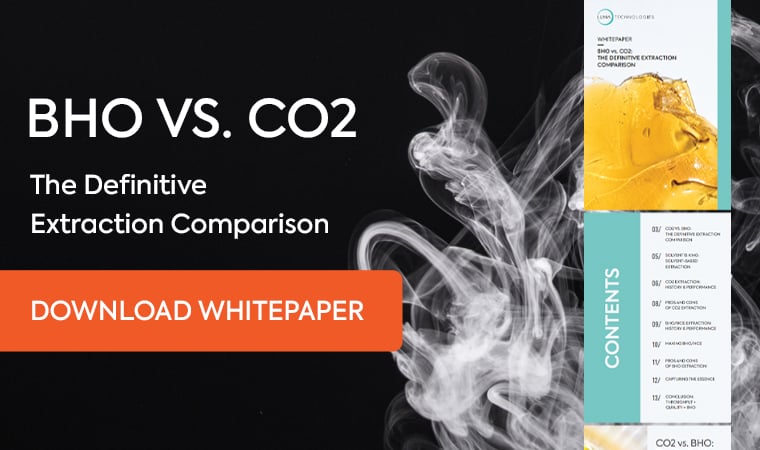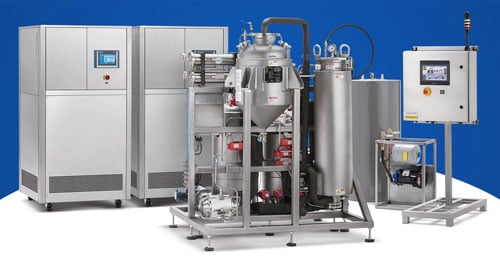
PureFlowN2: Improving IO Extractor Production Rate with Nitrogen Assist
2022 saw the fall of cannabis prices across North America. According to Bloomberg,
"The retail price of a gram of marijuana dropped 13% to $9.43 in the third quarter of 2022 from $10.83 in the same period a year earlier — the steepest fall ever seen for marijuana in 12 months, according to BDSA. Wholesale price declines were even more dramatic, especially in more “mature” markets that have had legal programs for longer, BDSA data shows. Colorado's average price per pound has declined 51% since the fourth quarter of 2020. In Oregon, it’s down 36%." (Kary, Tiffany (December 2022). Cheap Weed Has Become a Big Problem in the Pot Industry. Bloomberg)
Falling prices put pressure on margins up and down the supply chain. This co-occurred as cannabis markets matured and consumers became more educated and demanded higher quality products. There is a clear need for increased throughput without compromising product quality.
The current market for cannabis extracts demands top quality at low prices. The process the industry dubbed “nitrogen assist” can increase throughput while maintaining product quality, reducing operating costs, and increasing margins. In this process, nitrogen gas pressurizes extraction vessels to transfer fluid between vessels and equipment. While Luna Technologies has been implementing nitrogen assist for years at a research and development level, we chose not to bring it to market because of safety concerns.
Historically, nitrogen-assist processes have vented the nitrogen into the atmosphere at the end of each process cycle. This isn’t a safety concern as nitrogen is an inert gas and therefore doesn’t present a risk of fire or explosion. But when the nitrogen is vented, butane and propane are also released. There isn’t a practical and economical means of preventing the mixing of the LPG and nitrogen when venting. While other equipment manufacturers allowed and encouraged this practice, it was an unacceptable risk for Luna Technologies. But recent market conditions, i.e., pressure on margins for our customers, made us return to the drawing board to safely implement nitrogen assist on the IO Extractor and Oberon Extractor. That led to the design of PureFlowN2, the only closed-loop nitrogen assist process for Butane Hash Oil (BHO) extraction (also called hydrocarbon extraction).
PureFlowN2 is a hardware and software upgrade package that can be installed on all existing IO Extractors and Oberon Extractors. It includes additional automated process valves, process piping rerouting assemblies, a falling film evaporator, and a software upgrade that can be installed remotely.
This study examines the effects of PureFlowN2 on the production rate and extract quality of a Luna Technologies IO Extractor.
GOAL
The goal of the PureFlowN2 upgrade is to increase the production rate (pounds of cannabis processed per hour) without a decrease in product quality or yield.
Increase Production Rate
In BHO extraction, in general, there are three ways to improve the production rate:
1. Decrease batch cycle time
2. Increase batch size
3. Decrease machine downtime
This study aims to maintain batch size and machine downtime while decreasing the cycle time. Any decrease in batch size or increase in downtime will count against the reduced batch cycle time.

Maintain Product Quality and Yield
If the production rate increases but the product quality or yield decreases, then the business case for PureFlowN2 may not be valid. So yield and product quality are measured to maintain both with the addition of PureFlowN2.
This study calculates yield as the “bulk yield” or the ratio of total mass extracted to the total mass of input plant matter. Specific cannabinoid and terpene yields will not be calculated. Because we assume the extract will be sold as a retail product without further post-processing, the bulk yield is the actual yield from a business perspective. In other words, if a processor starts with 5,000g of biomass and extracts 1,000g of “bulk” extract, they will have 1,000g of sellable product. This is the case for most BHO extracts. Ethanol and CO2 extractions require further refinement after extraction, which involves mass loss, so bulk yield is not an appropriate metric for those methods. Maintain or improve cannabinoid and terpene yield.
Product quality is measured as the cannabinoid content and terpene profile of the extract. With the addition of PureFlowN2, the goal is that the mass percentage of each cannabinoid and terpene in the final product remains the same.
Baseline
The study's baseline involved assessing the performance of the Unmodified IO Extractor, which refers to the original design of the extractor without any modifications or improvements. The baseline was established by running five consecutive extraction batches using the Unmodified IO Extractor. Here are the steps and parameters involved in the baseline:
Biomass Selection: All biomass used in the experiment was of the same strain. This ensures consistency and eliminates any variability that could arise from using different strains of biomass. Additionally, the biomass was homogenized (mixed) to minimize any potential differences further.
Initial Weight Recording: The biomass weight used in each extraction batch was recorded before extraction. This step provides a baseline measurement for the biomass input, allowing for comparisons and calculations in subsequent analyses.
Extraction Batches: Five extraction batches were run consecutively using the Unmodified IO Extractor. Each batch followed the same extraction recipe and parameters, ensuring consistency throughout the baseline experiment.

Batch Processing Times: The processing time for each extraction batch was recorded. This refers to the duration it took for the extractor to complete the extraction process for each batch.
Downtime Measurement: The downtime between batches was recorded. Downtime represents the time it takes to unload the biomass from the completed batch, reload fresh biomass, and initiate the extraction process for the next batch. It accounts for the entire duration between one batch's completion and the subsequent batch's start.
Extraction Recipe Parameters: The recipe parameters used for each extraction batch were recorded. These parameters include temperature, pressure, solvent type, and other relevant factors influencing the extraction process. Ensuring that the extraction recipe remains the same across all batches allows a fair comparison of the extractor's performance.
Average Soak Temperature: The average soak temperature during the extraction process was recorded. This refers to the temperature at which the biomass is soaked or immersed in the solvent for the duration specified in the recipe. Monitoring the soak temperature helps to evaluate the thermal conditions experienced by the biomass during extraction and helps to account for variations in product quality.
Extract Mass: The mass of the extract after solvent purging was recorded to calculate yield.
By conducting the baseline experiment according to these steps and recording the specified parameters, the performance of the Unmodified IO Extractor can be assessed and compared against potential modifications or improvements in future iterations of the experiment.
PureFlowN2
After establishing the Unmodified IO Extractor baseline, the next step in the case study is to compare the baseline performance with the modified version, PureFlowN2 IO Extractor. The PureFlowN2 includes modification to the valves, process piping, heat transfer components, and software of the original IO Extractor. This modification aimed to increase the production rate while maintaining or improving yield and product quality.
To compare the PureFlowN2 IO Extractor with the baseline, the same steps performed in the baseline experiment were replicated with the modified extractor. The same biomass and extraction recipe was used for this study. Through this comparison, the performance of the PureFlowN2 IO Extractor can be assessed in terms of production rate, yield, and product quality. By evaluating the differences and improvements observed in these critical parameters, the effectiveness of the PureFlowN2 modification can be determined, and its impact on the business's extraction process can be understood.
One sample from each of the four conditions (fresh-frozen and cured and with/without PureFlowN2) was sent to an analytical testing laboratory to measure the chemical composition of the extracts.
Results
A sample Certificate of Analysis for the Fresh-Frozen Biomass is included below.

Conclusions
The study aimed to evaluate the effects of the PureFlowN2 modification on the production rate, yield, and product quality of the Luna Technologies IO Extractor. The experiment was conducted regarding falling cannabis prices and the need for increased throughput without compromising quality.
-1.png)
The results showed that the PureFlowN2 IO Extractor significantly increased the production rate compared to the baseline. For fresh-frozen biomass, the production rate was increased by 98.6%, while for dry biomass, the increase was 49.51%. This improvement in production rate is crucial for meeting the market's demands and maximizing operational efficiency.
In terms of yield, the PureFlowN2 IO Extractor maintained the yield for the most part. For dry biomass, there was a slight increase of 2.87% in yield, indicating improved efficiency in extracting desired compounds. However, there was a slight decrease of 0.57% in yield for fresh-frozen biomass. Despite this slight variation, the overall yield was still acceptable and within an acceptable range.
Adding PureFlowN2 did not negatively impact the quality of the extracted product. The cannabinoid content and terpene profile remained consistent with the baseline. This means that the modified extractor successfully maintained the desired chemical composition of the extract, meeting the quality standards expected by consumers.
Additionally, the extraction technicians noted an unexpected benefit of the PureFlowN2 modification. There was a decrease in moisture within the extraction equipment, which can have several advantages. The reduced moisture levels contribute to product stability, help prevent microbial growth, and decrease the maintenance required on the equipment.
In summary, the PureFlowN2 modification proved effective in increasing the production rate while maintaining or slightly improving yield and product quality. This enhancement addresses the challenges of declining cannabis prices and the need for increased throughput. The study demonstrates the viability of the PureFlowN2 upgrade as a solution to improve efficiency and profitability in the cannabis extraction process.
.jpg)
.jpg)
.jpg)
Reach Out to Learn More
Experience the quantum leap in cannabis extraction with PureFlowN2 Technology, setting new standards for efficiency, safety, and quality. Say goodbye to slow run times and hello to faster throughput and superior extracts that delight your customers. Luna Technologies invites you to embrace the future of extraction, where innovation and imagination merge to create a new era in cannabis processing. Are you ready to leap into extraordinary results with PureFlowN2? The future awaits!





